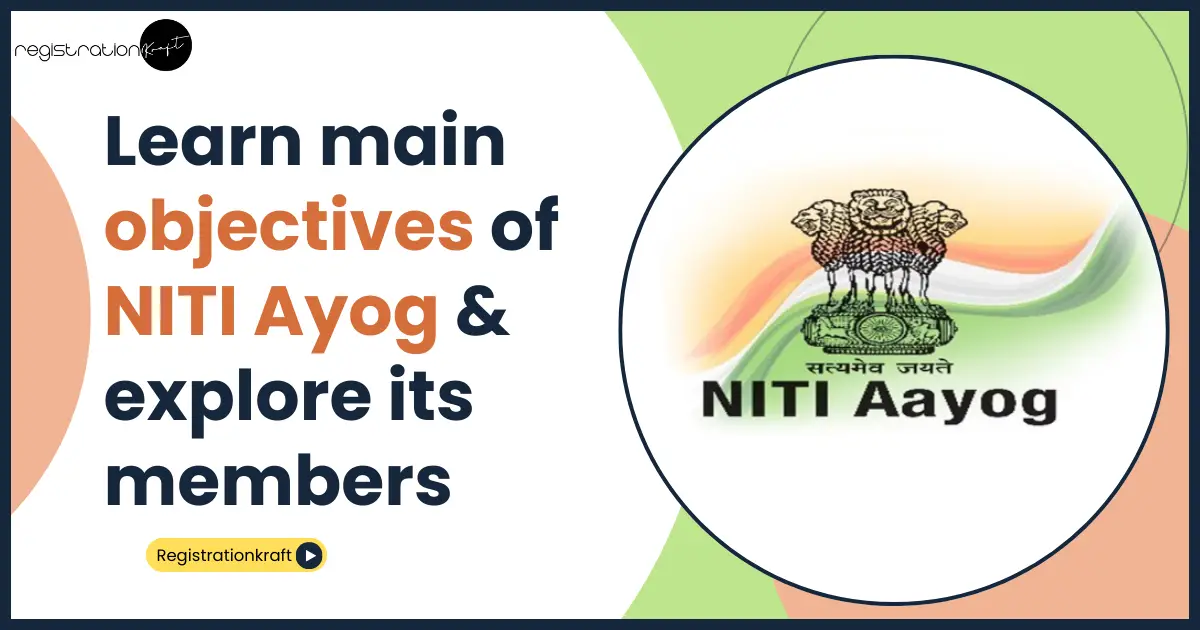Learn main objectives of NITI Aayog and explore its members

NITI Aayog, a policy think tank of the Government of India, was established on January 1, 2015.“NITI” is a Sanskrit term which refers to ethics, moral conduct, principles, or guidelines for proper behavior or governance. It is confined to the principles of morality, righteousness, and practical wisdom. The name perfectly blends with what the Government of India intends to do for the people.
“NITI” in NITI Aayog is actually short for “National Institution for Transforming India”. It is the policy-making institution of the Government which aims to build a strong and prosperous nation.
NITI Aayog replaced the former Planning Commission
Before NITI Aayog’s establishment in 2015, the Government had the Planning Commission but its utility and significance had been questioned for a long time. NITI Aayog provides information about various programs and policies of the government. It offers advice to the Central and State Governments as well as Union Territories. The Planning Commission had adopted the Five-Year Plans Model. Niti Aayog followed this model till 2017 only. NITI Aayog has a more flexible, cooperative federalism and encourages collaboration between State and Central Governments. As compared to the Planning Commission, it is more relevant and responsive to the present economic conditions and needs of the country.
Members of NITI Aayog
Prime Minister Mr. Narendra Modi is the Chairperson of NITI Aayog. The rest of the members of NITI Aayog are mentioned below:
- The Vice Chairperson is Suman Bery.
- These are 4 Ex-Officio Members in total: Amit Shah, Rajnath Singh, Nirmala Sitaraman and Arjun Munda.
- The Special Invitees are 5 in total: Nitin Gadkari, Piyush Goyal, Virendra Kumar, Ashwini Vaishnaw and Rao Inderjit Singh.
- The Full-time Members of the institution are 4 in total: V. K. Saraswat (former DRDO Chief), Ramesh Chand (Agriculture Expert) and V. K. Paul (Public Health expert), Arvind Virmani (Economist).
- The Chief Executive Officer (CEO) is B. V. R. Subrahmanyam
- The Governing Council consists of all Chief Ministers of States (excluding Delhi and Puducherry), Lieutenant Governor of Andaman & Nicobar Islands, and special invites.
Hubs under NITI Aayog
NITI Aayog aims to build a strong nation with powerful and secure states. There are two hubs under NITI Aayog known as “Team India Hub” and “Knowledge and Innovation Hub.”
- Team India Hub: This Hub ensures that the Indian States are involved with the Central Government and encourages cooperative federalism along the way. Team India Hub mandates the formation of policies and programmes in order to evaluate and resolve sectoral issues.
- Knowledge and Innovation Hub: This Hub is majorly responsible for the construction of the think tank capability of an institution. It consists of a systematic study of practical governance activities and passing on recommendations. The team is also inspired by the hub to establish fellowships with academic institutions and non-governmental organizations(NGOs)
The think tank institution is positioning itself as a State of the Art Resource Center that is equipped with all the essential tools, know-how, and skills to allow it to empower with speed, promote innovation and research, provide the government with critical policy vision and handle unforeseen problems. It was the expectations of the people for growth and administrative development which led to the establishment of NITI Aayog. This demanded institutional changes in the administrative structure and shifts in active strategy that could boost significant scale change.
Objectives of NITI Aayog
The following are the objectives of NITI Aayog:
- To promote active participation of States for fulfilling the national objectives
- To advance cooperative federalism through consistent, well-organized assistance programs and processes with the States.
- to come up with techniques for the development of a dependable plan at the village level and also progressively combining these at higher governmental levels.
- To form an economic policy based on national security interests.
- To pay extra attention to the groups inside society which are not able to benefit enough from the economic growth.
- To recommend long-term strategic frameworks and programmes and initiatives and to assess the relevance for these efforts.
- To encourage collaboration between national and international think tanks, educational institutions, policy research centers and significant players.
- To form a mutual community which consists of national as well as international professionals for encouraging knowledge sharing, innovation and an entrepreneurial spirit.
- To provide a forum to the departments and sectors for resolving conflicts so that the progressive agendas can be expedited.
- To maintain a state-of-the-art resource center which serves as a repository of research on good governance and most effective methods for just and sustainable development and help in spreading these studies to the parties that are interested.
- To effectively evaluate the execution of programmes and initiatives which includes determining resources that are necessary to increase the success’ likelihood.
- To focus on improving the technology and developing ability in order to carry out projects and programmes.
- To be a part of additional tasks which may be required to help in achieving the goals and carry out the national development plan.
Verticals of Niti Aayog
Niti Aayog consists of supportive bodies and verticals which help in the smooth functioning of the essential tasks by the institution. These supporting bodies and verticals are as mentioned:
- Administration and Support Units
- Agriculture and Allied Sectors
- Aspirational Districts Programme Cell
- Communication and Social Media Cell
- Data Management and Analysis, and Frontier Technologies
- Economics and Finance Cell
- Education
- Governance and Research
- Governing Council Secretariat and Coordination
- Industry-I
- Industry-II
- Infrastructure-Connectivity
- Infrastructure-Energy
- Micro, Small and Medium Enterprises
- Natural Resources and Environment, and Island Development
- Project Appraisal and Management Division
- Public–Private Partnership
- Rural Development
- Science and Technology
- Social Justice and Empowerment, and Voluntary Action Cell
- Social Sector-I (Skill Development, Labour and Employment, and Urban Development)
- Social Sector-II (Health and Nutrition, and Women and Child Development)
- State Finances and Coordination
- Sustainable Development Goals
- Water and Land Resources
7 Pillars of NITI Aayog
The NITI Aayog is based on 7 pillars of effective governance which are as follows:
- Pro-people: It fulfills the dreams of the society and the individuals it consists of.
- Proactive: It anticipates and attends to the demands of the people in the society.
- Participation: The involvement of the public.
- Empowering: It empowers the women in the society in all aspects.
- Inclusion of all: It promotes inclusion of all people. It doesn’t matter what caste, creed or gender they belong to.
- Equality: It provides equal opportunity to all, especially the youth.
- Transparency: It makes the government transparent and responsive.
Conclusion
NITI (National Institution for Transforming India) Aayog is a policy think tank institution which replaced the former Planning Commission in 2015. It ensures implementation of numerous government programmes and policies. NITI Aayog was formed by the Union Cabinet to serve policy inputs and information to the citizens or government officials. This institution primarily focuses on creating partnerships with major stakeholders, non-governmental, educational and research institutions. It fulfills the dreams of the society and the individuals it consists of. It empowers women in all aspects and promotes inclusion of all people. It doesn’t matter what caste, creed or gender they belong to. It promotes transparency and equality for the people who cannot avail the benefits of economic growth. It provides equal opportunities to everyone in the country with special focus on the youth.
Frequently Asked Questions (FAQs)
Q1. Who is the CEO of NITI Aayog?
As of now, BVR Subramaniam is Chief Executive Officer (CEO) of NITI Aayog. BVR Subrahmanyam is a former Indian Administrative Service (IAS) officer
Q2. Who is the Chairman of Niti Aayog?
Mr. Narendra Damodardas Modi (Prime Minister of India) is the Chairman of NITI Aayog.
Q3. Who is the Vice-Chairman of Niti Aayog?
Mr. Suman Bery is the Vice-Chairman of Niti Aayog at present.
Q4. Why is NITI Aayog better than the former Planning Commission?
NITI Aayog is better than the former Planning Commission that was just an advisory body. The Planning Commission did not have any powers for imposing policies and funds even though state governments did play an active role in decision-making under this body. NITI Aayog has the power to impose policies and allocate funds to different states. The Planning Commission had become redundant, it was relevant in a command economy structure but not any longer. NITI Aayog serves the present needs of the country in a more efficient way.
Categories: Gov Yojana
Tags: Niti Ayog, Objectives of NITI Ayog





